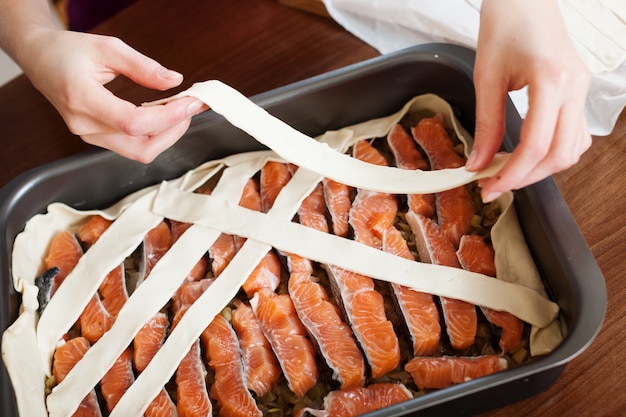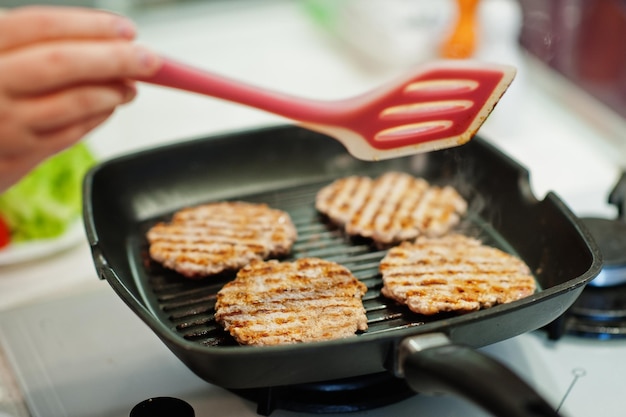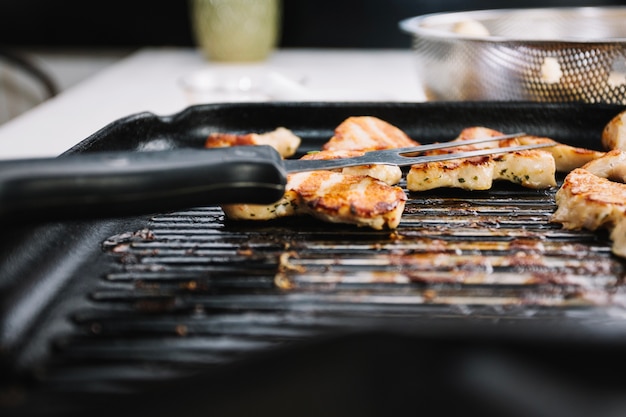Ah, the new york strip steak. The name itself evokes images of juicy, perfectly-seared meat, tender and flavorful, a culinary masterpiece that melts in your mouth. I’m a sucker for a good steak, especially a well-prepared New York strip. It’s got that perfect balance of marbling and leanness, and the flavor – oh, the flavor! But let’s be real, we’ve all been there – that moment when the steak ends up dry and tough, a culinary disappointment. It’s a shame, really, especially when you've got a beautiful piece of meat.
That’s why I’m spilling all my secrets in this guide – a foolproof method for cooking the perfect new york strip steak on the stovetop. It's not a mystical art, I promise. It’s all about understanding the basics, paying attention to those crucial details, and mastering a few simple techniques.
So, put on your apron, grab your trusty pan, and let's embark on a culinary journey together. From choosing the right cut to achieving that perfect sear and bringing out the best flavors in your steak, I’m going to walk you through every step. I'll even share some of my tried-and-true tips and tricks that I've picked up over the years, things that elevate the steak from good to absolutely divine.
Part 1: Choosing the Right Cut

The Importance of Quality: Finding the Right Steak
Let’s start at the beginning – with the star of the show. It all boils down to choosing the right cut, the foundation of a good steak. And for me, there’s no beating a New York strip, a beautifully marbled cut with a delicious depth of flavor. Ideally, you want a steak that’s about 1 to 1.5 inches thick. This ensures even cooking and allows for a gorgeous sear.
Now, don’t underestimate the importance of marbling. It’s that lovely white fat running through the meat. It's the key to a juicy, flavorful steak, adding tenderness and richness. Avoid anything too lean, as it’s more likely to dry out during cooking. You want that balance of fat and lean meat, which will ensure a perfectly cooked steak.
The Butcher’s Touch: A Valuable Resource
If you’re serious about your steak, your local butcher is your best friend. They’ve got the knowledge and expertise to guide you to the perfect cut. They can help you pick a steak with the right marbling, thickness, and quality to make your dish a winner.
Butchers are also great resources for understanding different cuts. They can tell you about the different qualities of each cut, how to prepare it best, and even suggest seasoning combinations that will elevate the flavor. It’s a relationship that pays off in delicious dividends.
Supermarket Savvy: Finding Quality in the Aisles
Of course, sometimes you can't make it to the butcher, and that's okay. If you’re navigating the supermarket, look for a steak with a good color, a rich red hue, and a slight amount of give when you press it gently. Avoid anything that looks dry, discolored, or feels too soft.
Also, pay attention to the packaging. Check the expiration date to ensure freshness. Sometimes, the supermarket will even have a meat counter with staff who can help you choose the best cut.
Part 2: Preparing Your Steak for Success

The Pat-Down: A Crucial First Step
You’ve got your beautiful piece of meat, now it’s time to get it ready to cook. And this step is crucial – pat the steak dry with some kitchen paper. You’d be surprised how much moisture is clinging to that steak. This step might seem insignificant, but it prevents excess moisture from steaming during cooking, ensuring a nice, crispy sear.
Seasoning to Perfection: The Art of Simplicity
Now comes the fun part – seasoning. You can get fancy, but I'm a firm believer in simplicity. Salt and pepper, generously applied, are all you really need to bring out the steak's natural flavor. You can add a touch of other spices like garlic powder, paprika, or onion powder, but use them sparingly.
Rub the seasoning all over the steak, making sure to cover both sides. Don’t be shy with the salt. It helps to draw out the moisture and enhances the flavor. A little salt goes a long way.
Resting for Perfection: Allowing the Steak to Relax
Once you’ve seasoned your steak, give it some time to come up to room temperature. This allows the steak to cook more evenly, preventing those cold spots that can lead to uneven doneness. Give it at least 30 minutes, an hour is even better.
Keep the steak covered in the fridge until you're ready to cook. While you're waiting, you can prepare your pan, get your sides ready, and let the anticipation build.
Part 3: Cooking the Steak: The Heat is On

Sizzling Pan, Smoking Hot: The Key to a Perfect Sear
This is where the real magic happens. Get your pan screaming hot! Really hot! I prefer a cast iron skillet. It holds heat beautifully and gives you that fantastic sear. But any heavy-bottomed pan will do. Heat it over high heat until it’s smoking. This is crucial. A hot pan ensures a crispy, caramelized crust, sealing in all those delicious juices.
If you’re using a cast iron skillet, it’s always a good idea to preheat it in the oven for 10-15 minutes. This helps ensure it’s truly scorching hot and ready to take on your steak.
Searing the Steak: The First Crucial Step
Okay, time to get serious. Gently place your steak in the hot pan. You'll hear that glorious sizzle – a sound that’s music to my ears! Don’t move the steak for about 3-4 minutes. Let it cook undisturbed. This allows for a perfect sear on the first side.
Be patient, it might be tempting to peek, but just let it cook undisturbed. The goal is that beautifully browned crust – a hallmark of a great steak.
Flipping and Finessing: The Art of Even Cooking
After 3-4 minutes, carefully flip the steak over to the other side. You want to avoid piercing the steak with a fork, which can cause the juices to escape. Use tongs or a spatula instead. Now, give it another 3-4 minutes, cooking it until it’s beautifully browned and has a nice sear on both sides.
This is where you start to rely on your intuition. You’ll feel the steak start to firm up, and the edges will become crispy. You can also lift it up to see how it’s browning. You want a nice, even crust all around.
Reducing the Heat and Adding Flavors: Bringing it Home
Once your steak has that fantastic sear, reduce the heat to medium-high. Now, add a knob of butter to the pan and a few sprigs of herbs, like rosemary or thyme. You can even add a clove of garlic. This is all about infusing the steak with delicious flavors.
Swirl the butter around and baste the steak with the melted butter and herbs. This will create a beautiful, glossy finish and add a layer of richness. You can even use a spoon to spoon the buttery, herby mixture over the steak as it cooks.
Part 4: Checking the Doneness: The Art of Perfect Timing
The Finger Test: An Old-School Method
This is the moment of truth – making sure your steak is cooked to your liking. You want that perfect balance of tenderness and a nice pink center. There are two methods you can use: the finger test and the meat thermometer.
The finger test is a classic, old-school method. Press your finger against the fleshy part of your palm. This is what a rare steak should feel like. For medium-rare, press your thumb against your palm. And for medium, use your index finger. It’s a bit of a sensory experience, and it takes practice.
The Meat Thermometer: For Precision and Consistency
If you’re not comfortable with the finger test, or if you want more precision, a meat thermometer is your best friend. There are plenty of digital thermometers available that are super easy to use.
For a rare steak, you’re aiming for 125°F. Medium-rare is 130°F, and medium is 140°F. You can adjust the temperature according to your preference. But remember, the thermometer should be inserted into the thickest part of the steak, avoiding the bone.
Resting the Steak: A Crucial Step
Once your steak is cooked to perfection, remove it from the pan and place it on a cutting board. Now, this is a critical step that many people skip – let it rest for 5-10 minutes before slicing. This allows the juices to redistribute evenly throughout the steak.
It’s a simple act of patience that makes a huge difference. It ensures a tender, juicy, and flavorful steak, the kind that melts in your mouth with each bite. You can tent it with foil to keep it warm while it rests.
Part 5: The Sides: Elevating the Experience
The Art of Balance: Pairing Your Steak with Sides
No steak is complete without a delicious array of sides. The right sides can elevate the entire experience, creating a symphony of flavors and textures.
I love a classic combination of mashed potatoes and green beans. The creamy mashed potatoes contrast beautifully with the crisp green beans, and both complement the richness of the steak. A simple salad with a vinaigrette dressing adds a touch of freshness and brightness.
A World of Choices: Finding the Perfect Companions
But don't be afraid to get creative! Roasted vegetables like asparagus or Brussels sprouts provide a delightful crunch. Sauteed mushrooms with garlic and herbs are another fantastic choice, adding a savory, earthy note. You can even pair your steak with a grilled corn salad for a summery twist.
Remember, the goal is to find sides that complement the flavors of the steak, creating a delicious balance on your plate.
Part 6: Plating and Serving: The Grand Finale
The Art of Presentation: Making Your Steak Shine
Your steak is cooked to perfection, the sides are ready, now it's time to put on a culinary show. Slice your steak against the grain, meaning cutting across the muscle fibers. This helps to make the steak more tender and easier to chew.
Arrange your steak slices on a plate, and don't forget those pan juices. Spoon them over the steak to add extra flavor and a beautiful, glossy finish. Add your sides, creating a colorful and inviting presentation.
A Touch of Flair: Adding the Finishing Touches
A sprinkle of fresh herbs, a drizzle of balsamic glaze, or a squeeze of lemon juice can add a touch of flair to your dish. These little details can make a big difference, elevating the visual appeal and creating a sense of artistry.
And finally, don't forget the finishing touches – a glass of wine, a crusty bread basket, and a warm ambiance will create the perfect setting for your steak masterpiece.
Part 7: Tips and Tricks: Mastering the Art of Steak
Seasoning Secrets: Exploring Different Flavors
Don't be afraid to experiment with different herbs and spices to find your perfect flavor combination. A pinch of cayenne pepper for a bit of heat or a touch of smoked paprika for a smoky depth can add an extra dimension to your steak.
Remember, it's your steak, so be bold and creative! Embrace the process of finding what you love.
Resting: The Key to Tenderness and Juiciness
Never skip the resting step. It’s a crucial part of the process, ensuring a juicy, tender, and flavorful steak. Cutting the steak straight out of the pan will release all those precious juices, leaving you with a dry and disappointing steak. Be patient, let it rest, and enjoy the results.
Pan Management: Avoiding Overcrowding
If you’re cooking multiple steaks, make sure not to overcrowd the pan. This will lower the temperature and prevent you from getting a good sear. Cook your steaks in batches, giving each one the space and attention it needs.
Achieving the Perfect Crust: Maximizing Heat
To achieve that perfect crispy crust, a cast iron skillet is ideal. But any heavy-bottomed pan will do. The heavier the pan, the more heat it will retain, leading to a more intense sear. You can even use a high-heat cooking spray to prevent the steak from sticking. Just remember, let the pan get screaming hot before you add the steak.
Butter Magic: Adding Richness and Flavor
Adding a knob of butter to the pan towards the end of cooking will infuse the steak with a beautiful richness and create a gorgeous, glossy finish. Don’t forget to baste the steak with the melted butter and herbs. It’s a simple trick that makes a big difference.
Part 8: FAQs: Addressing Common Questions
I'm sure you have some questions. Here are answers to some of the most common ones.
1. What if I don’t have a cast iron skillet?
No worries! Any heavy-bottomed pan will do, like a stainless steel pan or a nonstick pan. The key is to ensure the pan is hot enough to sear the steak properly. You can even use a grill pan for that beautiful grill mark pattern.
2. How do I know if my steak is cooked to the right doneness?
You can use a meat thermometer, which is the most accurate method, or you can try the finger test. Press your finger against the fleshy part of your palm to get an idea of what a rare steak feels like. For medium-rare, press your thumb against your palm, and for medium, use your index finger.
It's about finding what feels right to you. Remember, everyone has different preferences for their steak, so don’t be afraid to experiment and find what you enjoy most.
3. How long should I cook a New York strip steak?
The cooking time depends on the thickness of the steak and the desired doneness. For a 1-inch thick steak, you can expect to cook it for about 4-5 minutes per side for medium-rare. For a 1.5-inch thick steak, it will take about 5-6 minutes per side.
Remember, always use a meat thermometer to ensure that the steak is cooked to your liking. It’s better to err on the side of caution than to overcook your steak.
4. What if my steak is too dry?
If you’ve overcooked your steak and it’s a bit dry, don't despair! There are ways to salvage the situation. You can slice the steak thin and add a bit of sauce, like a red wine sauce or a mushroom sauce, to add moisture and flavor.
You can also try topping it with a creamy sauce, like a béarnaise sauce or a hollandaise sauce, which will help to add richness and tenderness. Even a simple drizzle of olive oil can help to soften the steak.
5. Can I cook a New York strip steak in the oven?
Absolutely! Oven cooking is a great option for multiple steaks or if you want to cook them to a specific internal temperature. Preheat your oven to 400°F. Season your steak, place it on a baking sheet, and cook for about 8-10 minutes per side for medium-rare.
Remember to use a meat thermometer to ensure that the steak is cooked to your liking. And when you take it out of the oven, let it rest for a few minutes to allow the juices to redistribute.
Cooking a perfect New York strip steak on the stovetop is a rewarding experience. It’s about understanding the basic principles, mastering a few simple techniques, and adding your own personal touch. It’s a culinary journey that will enhance your skills in the kitchen and create delicious memories. So, get those aprons ready, put on your favorite music, and get ready to enjoy the sizzle and the satisfaction of a beautifully cooked steak.
Everyone is watching

How to Cook Frozen Lobster Tails Perfectly: A Step-by-Step Guide
RecipesLobster. Just the word conjures up images of lavish meals, special occasions, and a taste of luxury. But let's...

Pigs in a Blanket Cooking Time: How Long to Bake for Perfect Results
RecipesAh, pigs in a blanket. Just the name conjures up images of those delightful little parcels of crispy pastry en...

Pork Fillet Cooking Time: How Long to Cook It Perfectly
RecipesPork fillet, or tenderloin as it's sometimes called, is a real favourite in our house. It's so versatile, and...

The Ultimate Guide to Tender, Juicy Pulled Pork
RecipesRight, let's talk pulled pork. It's one of those dishes that just screams "comfort food," doesn't it? I mean...

The Ultimate Guide to Cooking Delicious Frankfurters
RecipesLet's face it, we all love a good frankfurter. It's a classic, simple, and always satisfying. But let's be rea...
